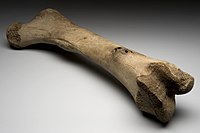
Photo from wikipedia
Matrix-assisted laser desorption/ionisation mass spectrometry imaging (MALDI-MSI) has been successfully used to elucidate the relative abundance and spatial mapping of analytes in situ. Currently, sample preparation workflows for soft formalin-fixed… Click to show full abstract
Matrix-assisted laser desorption/ionisation mass spectrometry imaging (MALDI-MSI) has been successfully used to elucidate the relative abundance and spatial mapping of analytes in situ. Currently, sample preparation workflows for soft formalin-fixed paraffin-embedded (FFPE) tissues, such as brain, liver, kidney, and heart, have been successfully developed. However, hard tissues, such as cartilage-bone, tooth, and whole mouse body, have resulted in the loss of morphology or tissue during the heat-induced epitope retrieval (HIER) step on commercially available conductive indium tin oxide (ITO) slides. Therefore, we have successfully developed a novel and cost-effective sample preparation workflow in which commercial conductive ITO slides are pre-coated with gelatin and chromium potassium sulfate dodecahydrate to improve the adherence of FFPE human osteoarthritic cartilage-bone tissue sections. Gelatin-coated ITO slides also resulted in overall higher N-glycan signal intensity for not only FFPE osteoarthritic cartilage-bone tissue but also for FFPE hard-boiled egg white used as a quality control to assess the quality of sample preparation and MALDI-MSI acquisition. In summary, we present a novel straightforward workflow to improve slide adherence and morphological preservation of FFPE cartilage-bone tissue sections during HIER while improving the signal intensity of N-glycans spatially mapped from the same tissue sections by MALDI-MSI.
Journal Title: Analytical and Bioanalytical Chemistry
Year Published: 2020
Link to full text (if available)
Share on Social Media: Sign Up to like & get
recommendations!